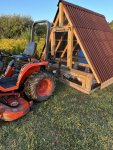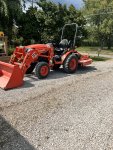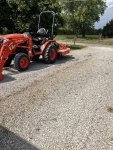johnjk
Well-known member
Lifetime Member
Equipment
B3200 w/loader, Woods RC5 brush hog, 4' box blade, tooth bar, B1700 MMM,
My neighbor has outside cats. A lot of them. The local hawk and owl population tends to keep them in check. Nothing better than watching a cat stalk a rodent while a hawk watches them.My wife LOVES those things. She would sit and watch it all day. The folks across the road have converted their farm into an event venue. Even having rodeos now. They have 3 or 4 regularly scheduled events and have one of those for each one to set up by the entrance to the property. We can see it from the front door.
Don’t really want the hawks to leave so much as just leave the girls alone. No hawks and I get overwhelmed with squirrels and chipmunks. I take a few out with my .22 cal pellet rifle, but it’s much more satisfying to watch a hawk snatch the life out of them. If a hawk gets them, I don’t have to bury them. Always a plus on rock hard clay. They’re beautiful birds and very beneficial because of firearms restrictions in the city limits. I’d be using something a bit more effective than a .22 cal pellet rifle. They will move on when they decimate the rodents. I’ve watched the cycle for 20 years.




